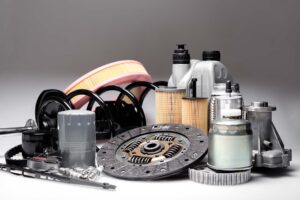When owning a car, taking good care of all its parts is very important. One particular component that’s important to maintain is the Cadillac converter. But do you know what does a Cadillac converter look like? Read on to learn more about this essential piece of gear, as well as why understanding its anatomy can be crucial for optimal performance and upkeep of your four-wheeler.
A Cadillac converter is essential to a vehicle’s exhaust system and is designed to reduce harmful emissions. It typically has a cylindrical or oval shape and is located in the exhaust system, between the engine and the muffler. While the specific appearance may vary depending on the make and model, the outer shell is usually made of stainless steel or another heat-resistant material.
What Does a Cadillac Converter Look Like – Physical Characteristics
First and foremost, let’s get one thing clear – here, I’m not talking about converters specifically designed for Cadillacs but about catalytic converters in general. That’s because a “Cadillac converter” is simply a mispronunciation of this essential vehicle component. After all, they do sound pretty similar. So, no matter if you’re a Caddy owner or not, let’s dive into this crucial and complex piece of gear.
The Dimensions Vary Depending on the Vehicle’s Make and Model
This essential component of modern vehicle exhaust systems typically resembles a cylindrical canister, often with a bulging appearance in the middle. Depending on the exact model, catalytic converters range from around 6 to 12 inches in length and 4 to 8 inches in diameter, but they are generally compact and lightweight.
External Components Play a Crucial Role in Effective Operation
The external components of a catalytic converter typically include inlet and outlet pipes, which connect it to the exhaust system, meaning the manifold and muffler, respectively. These pipes are designed to facilitate the flow of exhaust gases into and out of the component.
Additionally, the catalytic converters’ housing protects internal components, such as the catalyst substrate and heat shield. It’s typically made of stainless steel or other heat-resistant materials to withstand the high temperatures generated during catalytic reactions. It also helps to shield the surrounding components from excessive heat and prevents any potential leaks of the exhaust gases.

What Does the Internal Structure of a Cadillac Converter Look Like
The internal structure of this automobile part consists of several key components designed to facilitate the chemical reactions that reduce harmful emissions in vehicle exhaust gases. So, let’s answer the question – what does the inside of a Cadillac converter look like?
There Is a Ceramic or Metallic Substrate at the Core
At the core of this component is a ceramic or metallic substrate, often in the form of a honeycomb-like structure. This substrate is coated with precious metals, such as platinum, palladium, and rhodium, which act as catalysts. That means they promote chemical reactions that convert harmful gases, such as nitrogen oxides (NOx), carbon monoxide (CO), and unburned hydrocarbons (HC), into less harmful ones.
The substrate’s large surface area provides ample contact with the exhaust gases, allowing efficient interaction between the gases and the catalysts, efficiently creating less harmful substances such as nitrogen (N2), carbon dioxide (CO2), and water vapor (H2O). Moreover, to maximize the conversion process, the substrate is often coated with a wash coat layer, which further enhances the catalyst’s effectiveness.
There Are Also Oxygen Sensors
Modern catalytic converters are often equipped with oxygen sensors, and these vital components monitor the oxygen content in the exhaust gases. By measuring these levels, the sensor provides feedback to the engine control unit (ECU) to adjust the air-fuel mixture for optimal combustion and emission control.

How to Visually Identify a Cadillac Converter
Obviously, being able to identify this component is crucial for scenarios such as having to replace it due to damage or malfunction. However, being able to recognize a genuine catalytic converter also helps you avoid purchasing stolen or counterfeit units – they actually tend to be valuable targets for theft due to the precious metals they contain.
All in all, by understanding the characteristics and specifications of a legitimate component designed for their particular four-wheeler, car owners can ensure they purchase the correct replacement part, avoiding compatibility issues and maintaining emissions compliance.
Where Is It Located Under the Vehicle?
This component is typically located underneath the vehicle, along the exhaust system. Its exact position can vary depending on the vehicle’s make, model, engine configuration, and drivetrain. However, in most cases, catalytic converters are situated between the exhaust manifold, which collects the gases from the engine cylinders, and the muffler, which helps to reduce noise.
To locate it, simply follow the exhaust system from the engine towards the rear of the vehicle, looking for a cylindrical or oval-shaped component connected by pipes. While doing so, make sure to exercise caution, as this part of the vehicle can become very hot during operation.
Are There Some Visual Variations Based on Vehicle Make and Model?
As already mentioned, there can be visual variations in the design and appearance of this component based on the vehicle’s make and model. While the overall function and general shape remain consistent, the specific design and visual details can be quite different.
Different vehicle manufacturers may use distinct housing designs, including variations in size, shape, and material. The location of the inlet and outlet pipes can also differ between models. Overall, these variations ensure that the component is specifically tailored to fit within the unique exhaust system of each vehicle while still adhering to regulatory standards for emissions control.

Why Is a Cadillac Converter Important?
No matter if you own a brand-new car, a used vehicle, or even one with a salvage title, there are numerous reasons why catalytic converters are an unavoidable part of any four-wheeler:
- Reduction of harmful emissions – as mentioned, one of the primary reasons why this component is essential is its ability to reduce harmful emissions from vehicle exhaust and convert them into less harmful substances, minimizing air pollution and improving overall air quality,
- Environmental protection – by reducing the release of pollutants into the atmosphere, this vehicle component plays a crucial role in protecting the environment, including air quality, human health, and the well-being of various ecosystems,
- Compliance with emissions regulations – this component is required by law in many countries as a means to comply with emissions regulations, and it ensures that vehicles meet the government regulatory requirements and standards, helping to maintain a cleaner and healthier environment,
- Health benefits – the reduction of harmful emissions can have significant health benefits, as these pollutants can contribute to respiratory problems, cardiovascular diseases, and other health issues,
- Improved fuel efficiency – catalytic converters facilitate the combustion process by promoting more complete and efficient burning of fuel, resulting in better fuel economy, which can cut down car expenses for owners and reduce the overall consumption of fossil fuels,
- Longevity of the engine – as it reduces the levels of harmful substances that can negatively affect the internal combustion engine, such as unburned fuel and corrosive compounds, this component can actually help in protecting the engine parts from damage, ensuring their longevity,
- Global climate change mitigation – these parts indirectly contribute to the mitigation of global climate change, as they reduce emissions of greenhouse gases, such as carbon dioxide and methane, which helps in curbing the overall carbon footprint of vehicles,
- Noise reduction – although not their primary function, catalytic converters can also contribute to reducing the noise produced by the vehicle’s exhaust system by acting as a muffler, absorbing and dampening the sound generated during the exhaust process.

What Are Some Maintenance and Replacement Considerations?
Signs you’re dealing with a malfunctioning or damaged catalytic converter can manifest in various ways. One common indicator is a decrease in engine performance, such as reduced acceleration or power while cruising through famous routes in the US.
A failing unit may also cause the vehicle to experience poor fuel efficiency, leading to increased fuel consumption, or create a persistent sulfur-like odor emanating from the exhaust system. Additionally, it can trigger the check engine light on the dashboard of your four-wheeler or make unusual noises, such as rattling or hissing sounds, coming from the exhaust area.
Undergoing Professional Inspections Is Crucial
Professional inspections involve thorough visual inspections, exhaust system evaluations, and emission tests, which can be crucial in identifying and resolving issues with a vehicle, especially when it comes to catalytic converters. Skilled technicians can visually inspect the component, looking for physical damage, such as cracks, leaks, or clogging, as well as use emission testing equipment to measure the efficiency of the converter in reducing harmful pollutants.
Moreover, diagnostic tools, such as OBD-II scanners, can retrieve error codes saved in the machine’s computer system, and these codes can provide information about specific malfunctions or faults, helping technicians pinpoint the problem areas.
What Are the Costs and Options for Repair or Replacement?
All in all, your four-wheeler undergoing regular inspections can help you identify any underlying problems and address them accordingly. Obviously, the cost and options for repairing or replacing this component depend on the extent of the damage or malfunction, but here are some common case scenarios:
| Issue | Repair Options | Average Repair Cost |
| Clogged Converter | Cleaning, decarbonization | $100-$300 |
| Cracked Converter | Welding, patching, or partial replacement | $200-$500 |
| Failed Oxygen Sensor | Replacement of the faulty sensor | $100-$250 |
| Damaged Substrate | Replacement of the entire component | $500-$2,000 |
| Faulty Gasket | Replacement of gasket or seal | $50-$150 |
| Contaminated Converter | Fuel system cleaning | $100-$300 |
| Inefficient Converter | Replacement with a high-flow unit | $300-$1,500 |
Shedding Light on Appearance and Purpose Will Ensure You Know More About Your Ride
While a Cadillac converter might sound like something extremely complex, it doesn’t have to be. Understanding its basic components will give you a better idea of what to expect when replacing this part in your vehicle. So, before any replacement takes place, you should take matters into your own hands and learn about how the technology works, as well as seek advice from an experienced mechanic. As always, drive safely and stay informed!








